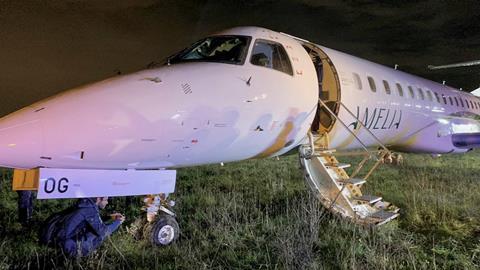French investigators have determined that an Embraer ERJ-145 conducted an unstable approach to Paris Orly before the aircraft landed fast and long, in a tailwind, and aquaplaned on the wet runway.
It touched down at 143kt some 1,150m beyond the threshold of runway 25 – about a third of its length – and passed through pooled rainwater, 4-5mm deep, from a storm in the vicinity.
Although the first officer, who was flying, applied the brakes he told the captain that the jet was not slowing. The captain took over as the aircraft reached 100kt, gently activating the parking-brake, and using right rudder in an attempt to vacate.
But the jet instead entered a skid and, veering slightly to the right, it overran at 80kt and passed by the ILS antenna before coming to rest 450m beyond the runway end.
None of the 42 occupants on board the Amelia International aircraft was injured and the jet (F-HYOG), arriving from Rodez on 20 October last year, sustained only minor damage.

But French investigation authority BEA has revealed poor crew resource management from the beginning of the approach.
It says the captain wanted to shorten the approach trajectory as much as possible, while the first officer’s aim was to maintain sufficient distance from the storm cells.
“Neither pilot clearly communicated their objectives to the other and the atmosphere in the [cockpit] deteriorated,” it says. “The [captain] took little regard of the [first officer’s] proposals. The [first officer] gradually faded away, realising that his contributions were not taken into account.”
The captain, it adds, began encroaching on the first officer’s function – including navigation management, speed selection and configuration – which excluded the first officer from decision-making and reduced his situational awareness. This also meant the captain was distracted from his own task of monitoring.
BEA says the pilots originally briefed at 28,000ft for an approach speed of 136kt and a landing with 45° flap. But as the aircraft descended to 3,000ft over the next 20min, the pilots disagreed over such matters as the choice of heading to avoid the storm.
When air traffic control cleared a descent to 2,000ft the crew did not hear the entire message, and the aircraft remained at 3,000ft. The jet, flying a shortened trajectory, was also travelling 60kt higher than the recommended speed for intercepting the ILS, and overshot the axis.
The first officer “quickly corrected” the horizontal course “to the detriment” of the vertical one, says the inquiry, leaving the aircraft above the glideslope.
Circumstances of the first officer’s heading change led to a change of vertical guidance mode. The captain “improvised” a procedure to capture the glideslope from above, the inquiry says, but neither the selected altitude nor vertical speed enabled the aircraft to return to the intended descent path.

BEA says the crew had earlier set 9° flap but the aircraft s airspeed was above the limit for 22° flap extension. While the landing-gear was deployed, the 22° flap selection was subsequently “forgotten”, it states.
Only after a period of manual control did the first officer manage to restore the aircraft to the glideslope, at about 1,500ft. The interception was “rapid, unprepared and poorly co-ordinated”, says BEA, and left the crew with high workload and less awareness of the aircraft’s energy and configuration.
Even though the crew had briefed for a 45° flap approach, it was more than 35kt above the airspeed limit for this setting, and the captain opted for 22° flap instead.
Four of the nine stabilisation criteria – airspeed, configuration, thrust, and ‘before landing’ checklist completion – had not been met by the time the aircraft descended through 1,000ft.
During the turbulent final approach the wind shifted, without the crew’s awareness, and resulted in a tailwind.
At about 240ft height the terrain-awareness system alerted the pilots to an incorrect configuration and the captain, realising the oversight, immediately selected 22° flap. But this late selection led to the flaps extending under the influence of ground effect. This aerodynamic situation, combined with the high approach speed and 20kt tailwind, caused the aircraft to float and touch down long.
“Although aware that this landing was long, the [captain] did not order the landing to be aborted,” says the inquiry. The crew had no information about the runway condition, it adds, and was “insufficiently prepared” for possible deterioration in the presence of storms.


























